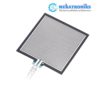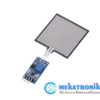Force Sensor Resistive film Pressure sensor FSR 406
About
- Resistive film pressure sensor 20g-10kg,
- robot balance tactile flexible force sensitive FSR.
- Force Sensor Resistive film Pressure sensor FSR
₨ 1,150
FSR Force Sensor Square Description:
FSR Force Sensor Square use in smart ageing & medical, automotive (vehicle accessories), smart furniture and smart mobile devices.
Sensor FSR Square The technology of force-sensing resistors was invented and patented in 1977 by Franklin Eventify.
This is a force sensitive resistor with a square, 1.75×1.5″, sensing area. This FSR will vary its resistance depending on how much pressure is being apply to the sensing area. The harder the force, the lower the resistance.
When no pressure is being applied to the FSR its resistance will be larger than 1MΩ. This FSR can sense apply force anywhere in the range of 100g-10kg.
Two pins extend from the bottom of the sensor with 0.1″ pitch making it bread board friendly. There is a peel-and-stick rubber backing on the other side of the sensing area to mount the FSR.
These sensors are simple to set up and great for sensing pressure, but they aren’t incredibly accurate. Use them to sense if it’s being squeez, but you may not want to use it as a scale.
FSR Force Sensor Square Product range: 20g-10kg,
- Sensor Type: Force Sensitive Resistor
- Controlled By: Voltage Divider
- Force Min: 1 N
- Max: 20 N
- Pressure Min: 10.3 kPa
- : 1 MPs
- Repeatability Error Max: ± 2 %
- Hysteresis Max: 10 %
- Long-Term Drift Max: 5 %
- Response Time Max: 3 μs en.wikipedia.org
- Temperature Sensitivity Max: 0.15 % per °C
- Sensing Area: 14.5 cm²
- Lifespan: 10 million actuations
- Temperature Min: -30 °C
- Operating Temperature Max: 70 °C

Force Sensor FSR Square Resistive film Pressure Sensor Model: RP-S40-ST
Material: polymer
Output Model Category: Analog Sensor
Sensor category: Pressure sensitive and force sensitive sensors
Working voltage: 3.3V - Force-sensing resistors consist of a conductive polymer, which changes resistance in a predictable manner following application of force to its surface.
- They are normally supply as a polymer sheet or ink that can be apply by screen printing. The sensing film consists of both electrically conducting and non-conducting particles suspend in matrix.
- The particles are sub-micrometer sizes, and are formulated to reduce the temperature dependence, improve mechanical properties and increase surface durability.
- Applying a force to the surface of the sensing film causes particles to touch the conducting electrodes, changing the resistance of the film.









There are no reviews yet.